Authors: Dean T. Kashiwagi, PhD., Charles Zulanas, M.S., Dhaval Gajjar, PhD.
An Alpha roof is a type of Spray Polyurethane Foam (SPF) roofing system that has been documented to be one of the highest performing roofs in the industry. Despite the high level of performance of the Alpha SPF roofs, owners still try to protect themselves by purchasing warranties. When the Dallas Independent School District (DISD) did not receive enough funding to purchase the Alpha roofs for their school buildings, general contractors started shopping the Alpha contractors. The demand for Alpha roofs during DISD bond programs exceeded the supply of Alpha vendors. DISD lowered the requirements and the contractors and manufacturers delivered lower quality roofs. DISD still required the performance of the Alpha roofing system, even though they bought lower performing systems without the quality control requirements of the higher performing Alpha roofs. DISD was not happy with the lower performance on some of the inexpensive roofs. This paper describes a case study that proposes that high roof performance is a result of expert contractors proving their past performance, detailed preplanning, manufacturers doing quality control, contractors tracking their time and cost deviations and independent third party inspections. The expert Alpha contractor completed the project with the best dimensional stability metrics (dimensional stability is a metric of long lasting roofs). The roof installation was completed in 20 days and saved DISD over 20% of the cost of the roof, despite an increase in the scope of work. It was the first DISD project that had no punch-list items after the final walkthrough. DISD was extremely satisfied with the roof and the Alpha program demonstrated its effectiveness in the installation of roofs.
Keywords: sprayed polyurethane foam, Alpha roofing, SPF, Weekly Risk Report.
Introduction
The Sprayed Polyurethane Foam (SPF) is a lightweight renewable roofing system. If installed correctly, SPF roofing systems have great value due to their insulating properties, and ability to be installed over existing built up roofing systems. This minimizes environmentally hazardous material disposal of the traditional built up roofing (BUR) system (which the SPF roof system can encapsulate).
SPF roofing systems make up less than 3% of roofs in the industry (Kashiwagi, et. al, 2016a). The main drawback is the highly technical installation requirements of the two-component SPF roofing system that is installed in place. The correct installation of the SPF system is the most challenging and risky component of the roof system. This makes the performance of the system dependent upon the expertise of the contractor. The number of contractors who can install the system properly in the United States has been declining (PBSRG, 2016b).
Owners have attempted to require manufacturer’s warranties to ensure a 20-year performance of SPF roof systems. By observation and industry documentation, the industry has spent over 35 years trying to ensure performance through warranties; this approach has not been successful. The roofing industry does not have a good record of honoring warranties. Over 80% of all building construction problems involve roofing and waterproofing (Gajjar, et. al, 2014). Many SPF manufacturers utilize the warranties as a marketing gimmick. After the initial year of bonding responsibility has elapsed, manufacturers use the following techniques to invalidate the warranty (Lindus, 2015; Morin, 2017; Roofing Southwest, 2016; Shultz, 2016):
- Use warranty clauses to nullify the warranty if the owner does not perform annual inspections and maintenance of their roof, did not keep debris off the roof, modified their roof equipment without proper notification to the manufacturer, walked on their roofs without authorization, or did not report problems in a timely manner.
- Warranty only covers roof leaking. It does not cover system defects such as blistering of the SPF.
- Identifies the leak was caused by an issue the warranty does not cover.
- Contractor and Manufacturer will not respond to the owner.
- Manufacturer will blame the cause of the leak on the improper installation by the contractor.
One way that has been successful in ensuring high performance of SPF roofs when a lower performing contractor is used, is by a manufacturer’s quality control system. This is the Alpha SPF roof program which ensured the quality control system, preplanning from contractors, and a third party roof inspection that compared the installed urethane coated SPF roof system to the required thicknesses and performance metrics of the specifications.
The Alpha SPF roofing system has been documented as a high performing system (Kashiwagi, et. al, 2016a). It is made of two components: the sprayed polyurethane foam (SPF), and the highly protective urethane coating system (protects against UV degradation, foot traffic, and hail damage). The Alpha roof has also been proven to protect a building against severe hail, having passed the Factory Mutual Severe Hail test (1.75 diameter hailstones) on existing roofs multiple times (Kashiwagi, et al, 2016b; Zulanas, 2017). Contractors installing the Alpha roof systems must be a certified member of the Alpha program. The Alpha program requires contractors to maintain a high level of performance on all roofs they install.
The Dallas Independent School District (DISD) recognized the value of the system and used the Alpha roofing system to protect many of their buildings. Being in a location that receives hail regularly, DISD found the roof to be a great value proposition for its buildings. They have been putting the Alpha SPF roof on their buildings for the past 30 years.
Since 1987, Neogard has implemented the Alpha roofing program to identify the best contractors in the industry and to measure the performance of their roofs. As a result of Neogard’s motivation to change the industry, the performance on Alpha roofing system has been heavily documented. Table 1 (a-c) includes the Performance Metrics of Neogard’s Alpha Contractors, Alpha Contractor Requirements, and an Overview of Neogard’s Coating Warranty Coverage (PBSRG, 2016b):
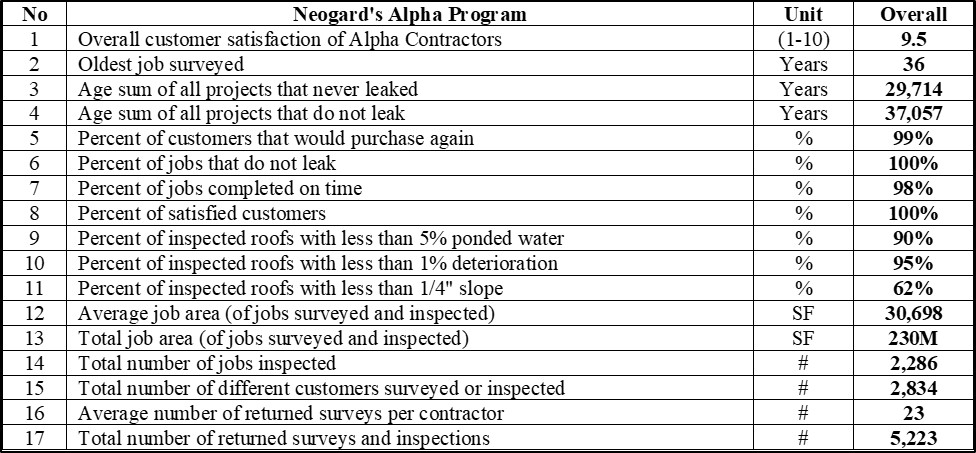


These performance metrics document significant results in the SPF roofing industry. The Alpha roof system has shown consistent high performance (9.5 out of 10 customer satisfaction rating and 99% of customers saying they would purchase an Alpha roof system again) on over 229 million square feet (SF) of surveyed roof. Neogard’s Alpha Roofing System’s past performance outmatches any other roofing system’s performance history (Zulanas, 2017).
The Alpha SPF roof system has the following attributes (Kashiwagi, 2016; Kashiwagi, 2015):
- It is lightweight.
- It is renewable.
- It is hail resistant to hail sizes up to 1-3/4 inch hail as tested by the Factory Mutual Severe Hail (FM-SH) test 4470 within the 15-year warranty period.
- It is green as it provides the highest insulating value and minimizes the need to remove the existing BUR roof system. All new traditional 20 year modified bitumen roofs require the removal of the existing roof system.

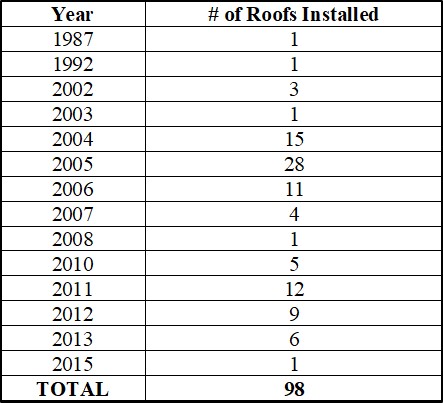
In the mid-1980s, DISD needed to replace some of their roofs, but did not have enough funding to meet the requirement of traditional modified bitumen roofs. Due to the lower cost of the Alpha roof system, Alpha roofs were specified (up to 33% lower cost) (Kashiwagi and Pandey, 1999; Zulanas, 2017). When the costs for Alpha SPF roofs were still outside of their budget in the early 2000’s, DISD specified that they required lower costing SPF roofs (minimum coating millage for ten year roof warranties) of the same quality. Due to the lower requirement for ten year roofs (instead of the Alpha 15 year hail warranty), the Alpha manufacturers did not perform the careful review of contractor preplanning, quality control system including pre-planning activities, tracking of time and cost deviations, and third party inspection. Figure 1 shows the lack of quality of installation based on the percentage of roof area blistered.
The DISD construction management group then made crucial mistakes. They allowed the general contractors to shop the Alpha contractors for lower prices. They also allowed a low bidding contractor to take a majority of the work. The manufacturers did not enforce the Alpha program technical requirements (preplanning, track risk, time, and cost deviations, and have third party independent inspections). Some of the roofs did not perform well (Figure 1 and Table 2). The DISD engineering group was discouraged with the poor performance and minimized the use of the Alpha SPF roof system, regardless of the lower cost.
DISD did not understand that in order to install high performing roof systems, they needed to hire high quality contractors who would install high quality Alpha SPF roof systems and ensure that they had a quality control plan in place. They also did not realize that the length of the warranty is immaterial to ensuring a high performing roof. DISD installed over 4 million square feet of the Alpha SPF and additional lower costing SPF roofing systems. When installed correctly, the Alpha SPF systems performed for 25 years, with a recoat capability to last another 15 to 20 years, as documented by the Casa View Roof and the Fosters Elementary Roof Hail Testing (Kashiwagi, et al, 2016a; Kashiwagi, et al, 2016b). However, when DISD adjusted the requirements and allowed the general contractors to hire the lowest costing roofing contractors they received roofs that were installed incorrectly and the roofs did not perform as expected. DISD expected the 10-year warranted roofs installed by low bidding contractors to last beyond their 10-year warranty period. When installed correctly, the Alpha SPF roofing systems exceeded their performance expectations. The Alpha Program’s performance metrics on DISD projects can be seen on Table 3.
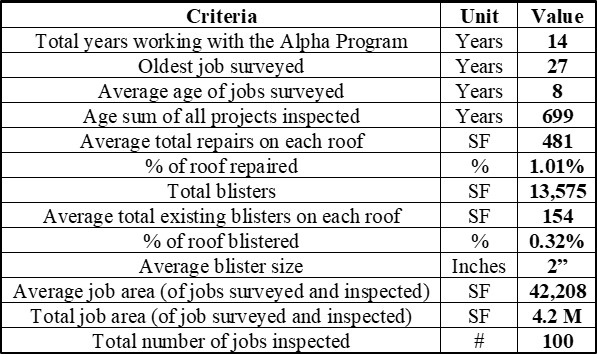
Problem
Despite the high performance of the Alpha systems, because DISD allowed low performing contractors that did not adhere to the Alpha program to install roofs on their buildings, there were SPF roof systems that failed and had to be removed. Table 4 is a list of roof systems, which were irreparable, and were removed and replaced by modified bitumen (MB) roof systems. The owner blamed the manufacturer for the failed roofs because the manufacturer had issued a warranty. The problem is complicated because each SPF roof system has two major manufacturers: the manufacturer of the protective polyurethane coating and the manufacturer of the SPF system. The SPF manufacturer blamed the contractor for faulty installation, and would not fix the roof. In their defense, the contractor is most likely the cause of SPF problems. This is supported by the performance information of failed DISD SPF roof systems.

The performance information on the failed roofs identified the following:
- All the failed roofs were installed by one contractor that did the work for very low prices.
- The contractor used a SPF that was not pre-approved on three of the roofs.
- The contractor and manufacturer did not perform quality control on the roofs.
- DISD continued to allow the contractor to install their roofs due to their low prices. The manufacturer and Alpha Program allowed the contractor to remain in their programs as well.
PBSRG recommended to DISD and the manufacturer of the Alpha SPF protective coating that attempting to minimize the risk of nonperformance through warranties was not effective in repairing the poorly installed SPF roof systems. PBSRG designed a new approach that ensured the correct installation of the Alpha SPF roof system.
However, because of the failed roofs, the DISD engineering group did not feel the performance of the Alpha SPF roofing system was an economical option when compared to a 20-year MB roofing system. Roof installation websites claimed that SPF roofs require more maintenance than MB and require recoating every 10 years (Improvenet, 2014). Additionally, other sites claim that based off cost and maintenance, built up roofs and MB are the best value, lasting up to 30 years (Maintenance Solutions, 2015). However, a study of Carnegie Melon’s roofing system over 20 years found that the average cost of roof replacement, including the repairs for MB roofs was $269 per square meter, equivalent to $24.75 per square foot with an average leak rate of 5.2 leaks per building per year (Coffelt, 2010). The roofing expert for DISD reported that the average price to apply a traditional MB roof, with tear off, on a commercial building is approximately $16 to $19 per square foot. Today, most SPF roofs at DISD are being replaced by costlier MB roofing systems even though the cost of the recoating and maintaining the Alpha SPF roof system is half of the MB system. (Casa View Roof and the Fosters Elementary Roof Hail Testing; Kashiwagi, et al, 2016a; Kashiwagi, et al, 2016b).
Proposal
PBSRG proposed that the only way to minimize the risk of nonperforming SPF roofs was to:
- Assist the Alpha contractor to identify the roof requirement before they installed the SPF roof system.
- Force the Alpha contractor to identify if the SPF roof system could actually be used successfully on the roof being considered.
- Have the Alpha contractor provide a weekly risk report (WRR), to all stakeholders that would track the project’s schedule and cost and time deviations. This would create transparency and minimize disagreements between parties when issues occurred on the project.
- Identify the contractor as the key to high performance.
- Identify that the contractor selected has the capability to perform, by showing past performance and by making them responsible to minimize the risk of nonperformance of the Alpha SPF roof system through pre-planning and documenting project performance.
Methodology
The following steps were accomplished in 2015 and 2016:
- A quality assurance and quality control system was developed for the Alpha SPF roof system.
- Responsibility of the SPF defects was moved from the coating manufacturer to the SPF manufacturer or the contractor. If the contractor does not fix SPF defects, they would be removed from the Alpha Program (a requirement for contractors to bid on DISD SPF roof projects).
- Ran a case study of the installation of an Alpha SPF roof system utilizing the quality control system and collected documentation on the performance of the project.
- Conducted an analysis of the performance of the roof installation.
Development of the Quality Assurance and Quality Control System
The initial Alpha Program was based on past performance of roofs installed and customer satisfaction of the clients of the roofs. The Alpha Program manufacturer (of the protective polyurethane coating) did not want to take the liability of the installation of the SPF roof system. However, to convince DISD of the value of the Alpha SPF roofing system, they provided them with a manufacturer’s warranty that covers all SPF defects. The manufacturer only agreed to this warranty if the contractor that installs the roof is part of the Alpha program. To be a part of the program the contractor has to maintain the following performance requirements:
- 98% of all roofs not leaking.
- 98% customer satisfaction.
- Annual surveys of all SPF roofs installed.
- An inspection every other year of 25 or more roofs being installed.
- Response to a leak or customer dissatisfaction within a week.
- Fix defects within two weeks unless given more time by the owner’s representative.
If the contractor does not keep the above requirements, they are removed from the Alpha Program. DISD is the only owner of SPF roof systems that has the Alpha Program motivating contractors to fix any defects on their roof systems.
The contractor responsible for the low performing DISD roofs (that led to replacement) received satisfied responses every year from the DISD roofing manager. DISD was therefore partially responsible for the failed roof systems because the DISD roofing manager provided satisfied responses, indicating the job was being performed correctly. The contractor finally went out of business, possibly when faced with having to take responsibility for their failures. The Alpha manufacturer was also connected to the defects because the replaced roofs were not quality controlled by the manufacturer and the contractors were not required to identify the requirements of the unique roofs by third party inspections.
PBSRG modified the Alpha Program with the following changes:
- The contractor would have to hold a clarification meeting at the roof site with all stakeholders (client, roofing engineer/consultant, contractor, manufacturers of Alpha coating and SPF) before the contract award. The contractor would be required to keep the meeting minutes.
- The contractor would have to run a moisture survey of the roof. A wet existing roof system is the largest risk to a properly installed SPF roof system.
- The contractor would be required to run a WRR that identifies the performance metrics of temperature, moisture, time and cost deviation from the planned schedule.
- Third party inspection and identification of performance metrics of the installed SPF (compressive strength and thicknesses) and protective Alpha coating (adequate thickness).
- The Alpha coating manufacturer issues a 15-year hail warranty on the coating.
- The contractor is responsible to maintain the condition of the SPF through annual inspections of their roof systems. If the contractor can get their SPF manufacturer to write a warranty to cover all SPF defects, the client gets an additional guarantee and the contractor gets the manufacturer’s support. The Alpha coating manufacturer does not have to be responsible for SPF defects.
The researchers proposed to the DISD that this was the most comprehensive SPF roof warranty and quality control system in the industry. Regardless of manufacturer’s reaction to warranty claims, DISD insisted on using warranties.
Dallas Fort Worth Urethane (DFWU) is the highest performing SPF contractor servicing DISD (longevity of performance, customer satisfaction, no leaks, and no needed repairs). DFWU does not have any claims for blistering roofs against SPF manufacturers. DFWU identified that they do not have any outstanding blistering claims on their SPF roof systems and have repaired any SPF defects on the roofs installed at DISD.
Due to their high performance, DFWU, requested and received from their SPF manufacturer, to write a warranty covering all SPF defects (regardless of source of risk). This is the only SPF manufacturer warranty in the industry with this stipulation. The only contractor in the Alpha Program currently covered by this warranty is DFWU. The performance of DFWU resulted in a warranty that minimizes the risk for DISD. By observation, because there has been no risk of unrepaired SPF roof system defects on roofs by DFWU, the warranty is issued. The warranty is not the risk mitigation mechanism. The risk mitigation mechanism is the high performance of DFWU. This is the intent of the high performance Alpha Program. DFWU performance and performance with DISD are shown in Tables 5 and 6.
Case Study at William Lipscomb Elementary
In the fall of 2015, DISD, the 14th largest school district in the United States, bid out a roofing recoat project for William Lipscomb Elementary. Using a Job Order Contractor (JOC), DISD allowed the contractor to bid out the roofing work to non-traditional roofing applicators, such as Alpha SPF roofing applicators. After reviewing multiple bid proposals, the group did not select the low bid offer, but selected DFWU, a roofing applicator part of the Alpha program.
Throughout their participation in the Alpha Program, DFWU, had been noted to be one of the best SPF roofing applicators in the entire country (see Table 5). DFWU’s performance record at DISD is listed in Table 4. DFWU additionally agreed to film the course of the entire project to give additional documentation of the installation.

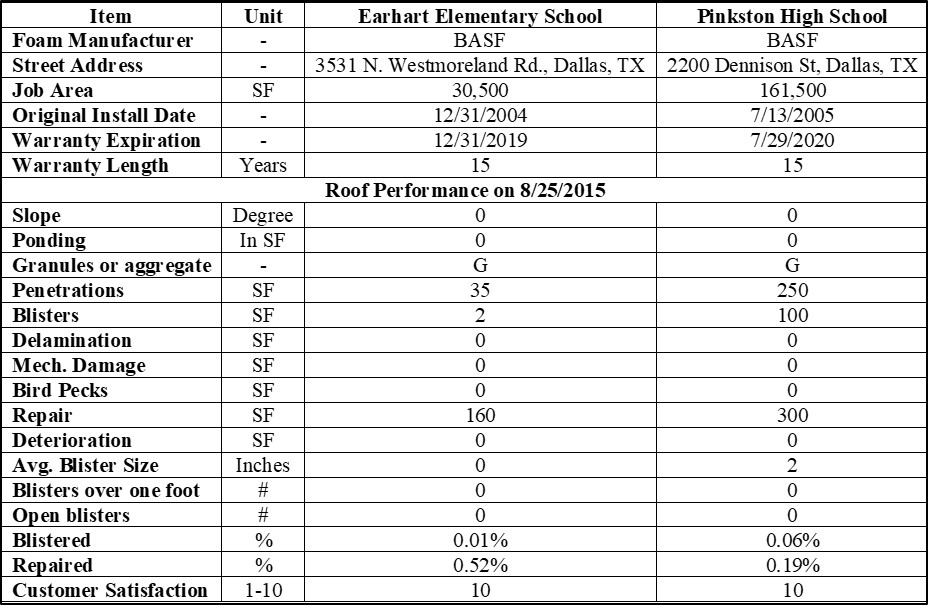
The William Lipscomb Elementary had a 17,578-square foot built up roof over coal tar pitch with constant leaking problems over its 15+ years of service, see Figure 2 and 3 for pictures and drawings of the roof. The roof included two HVAC units, two 4″ vents, miscellaneous plumbing stacks, gas line and one roof hatch. The roof hatch was scheduled to be screwed shut and foamed over. One of the reasons for utilizing the SPF roof system was savings of over $100,000 versus the removal of the existing system and installing the more traditional MB roof. The Alpha SPF roof may also extend the service life up to 45 years after two recoats of SPF, as was seen from the performance information on Alpha roofs installed at Casa View and Foster’s Elementary school (Kashiwagi 2016a; Kashiwagi, 2016b).

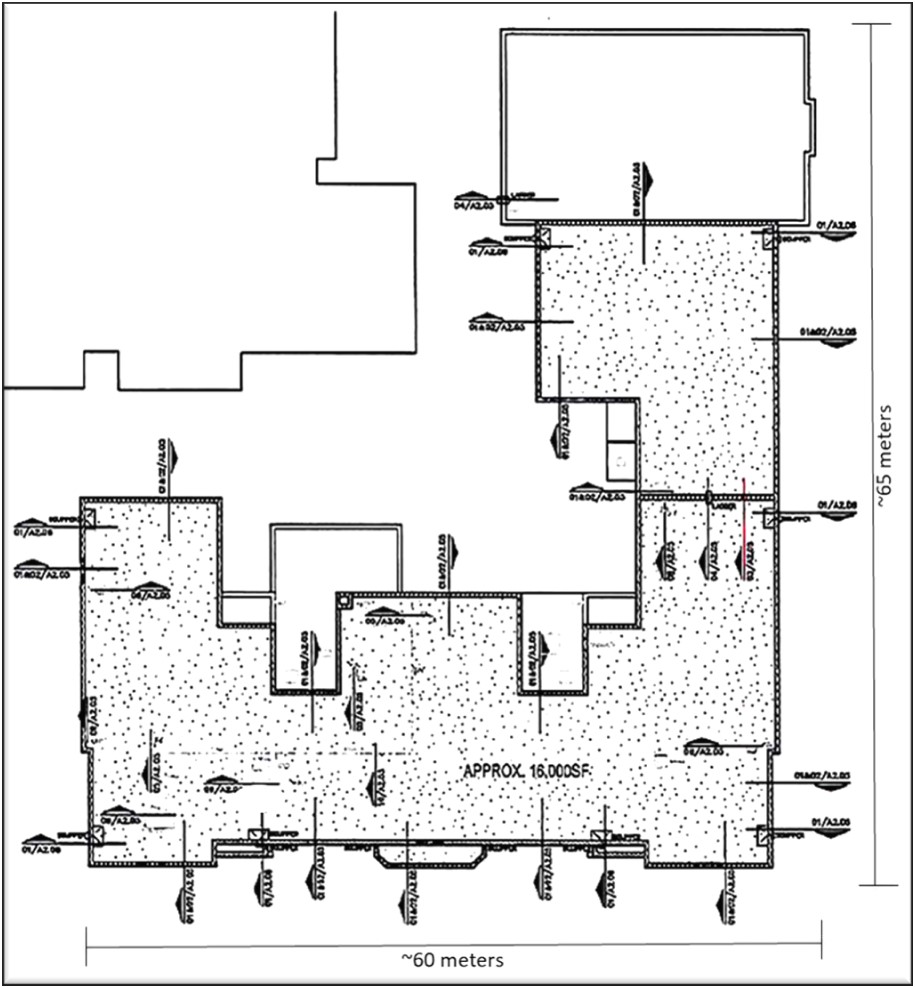
Tracking Project Deviations
From the beginning of the project, DFWU utilized a WRR as part of the Alpha Program requirements. The WRR is composed of the following components:
- A Project Setup tab – which describes the basic information on the project and the information that is known about the scope of work, contact information, the warranties and the level of expertise of the DFWU’s SPF applicators.
- Progress Report tab (see Appendix A) – which is a weekly log that clearly shows what DFWU accomplished during the week, which the key stakeholders can view and understand what is being done on the project.
- Milestone Schedule tab (see Appendix B) – which is the schedule for the project that is projected by DFWU. DFWU was required to create a milestone schedule at the beginning of the project. Throughout the project, DFWU would track the project to make sure every task was on schedule. Any part of the project that was not running according to schedule would have to have a risk number associated with it, which let the stakeholders know what caused the schedule to be delayed on the Risks tab.
- Risks tab (see Appendix C) – this tab shows all of the risks that occur on the project that are causing deviations to the DFWU’s anticipated scope. The risks tab shows the name of the risk, the contractor’s plan to mitigate the risk, the effect of the risk to the project regarding time and cost deviations, the entity causing the risk and the severity of the risk.
- Risk Management Plan tab – documents at the beginning of the project, the different potential risks that could occur on the project and shows how the contractor would be able to mitigate this risk from occurring on DFWU’s project. The Risk Management Plan also allows the stakeholders to understand the repercussions of each of the risks should they occur, which motivates the stakeholders to ensure that they do not make that mistake.
- Performance Metrics tab (see Appendix D) – provides quality assurance for the client by illustrating that DFWU is ensuring high quality work and is not taking shortcuts. In the case of the DFWU roof installation, the Performance Metrics tab shows the weather and roof conditions that could potentially affect the quality of the roof installation.
- Report tab (see Appendix E) – this tab summarizes all of the previous tabs in order for the stakeholders to see the progress on the job without reading the details.
The WRR is sent out to the key stakeholders each week to assure the client that the project is running smoothly and to inform the clients and key stakeholders about any risks occurring or that might occur on the project. Initially, the Job Order Contracting (JOC) project manager and the Trevino Group (under DISD), attempted to manage the distribution of the WRR to key stakeholders. They argued incorrectly that the WRR was a contractual document, and would only be a communication medium to contact the client. The Trevino Group representative stated, “The Trevino Group is responsible to the Owner for this project, therefore, any schedules or documents required will need to go through me” (PBSRG, 2016b).
The WRR is not a contractual document, but information on the project that allows all parties to understand the project’s progress. In attempting to control the distribution of the WRR, DFWU would have been unable to communicate their needs effectively to the client. Shortly after some clarification, the Trevino Group permitted the distribution of the WRR to the client on a weekly basis. The WRR provided transparency to all stakeholders when the schedule deviations occurred, eliminating disagreements between parties throughout the project and after the project.
Time Deviations
DFWU continually tracked the time deviations throughout the project to minimize the impact of the client delays, and still finish the project with their modified schedule of 6/8/2016. DFWU finished the project in less than 20 days after final approvals by DISD. DFWU finished the project on time as shown in Table 7, despite many delays caused by the owner. Table 7 also shows which risks affected the project activities.

Some of the major setbacks on the roofing installation included the following:
- DISD delayed signing the purchase order until March 31, though the bid had been won by DFWU in January.
- DFWU’s subcontracted gravel crew was unable to work for one month due to the architect not signing the Notice to Proceed at the right time.
- Delayed inspection and approval of DFWU’s roofing installation permit by the Historical Landmark Commission.
- DISD’s decision on foaming over the small roof hatch, which was the only internal access point for DISD to get on the roof.
After a clarification meeting on 3/16/16, without a purchase order issued from DISD (normally contractors do not do anything until they receive a purchase order), DFWU documented all of the existing roof information at the school, identified the risks for the project and set up an initial schedule for how long the project would take. DFWU documented this information on a WRR so DISD and the Trevino Group (the Job Order Contractor who was given the task order) could be informed and up to date on the status of the project.
After receiving a Purchase Order from DISD on 3/31/16, DFWU planned to remove the gravel from the roof on 4/7/16 with hired subcontractors. The subcontractors had their machines ready for gravel removal at the school on 4/7/16. However, the architect was unaware that the submittal would cause the project to be delayed, and did not sign off on the submittal. As a result, DFWU lost 30 days on the project because the subcontractors were unavailable to complete the gravel removal later in the week due to other work commitments.
After the JOC contractor completed the necessary requirements (the week of 4/11/16), DFWU applied for a permit from the City of Dallas. The permit was put on hold due to not having a signed approval letter from the Historical Landmark Commission. DFWU had pre-notified the JOC contractor that this would be required, but they still did not receive it in time causing the delay. The risk that DFWU managed was that because William Lipscomb Elementary School was a historical building, the Landmark Commission would protest the project if the roof’s coating was installed over the front of the building. On the other hand, if the termination point of the coating did not go over the edge of the front enough, it would have affected the Neogard manufacturer’s warranty. DFWU worked with the architect who drew out new designs that were suitable for both parties, which eliminated any delay on the project.
The final delay on the project was the roof hatch. The roof hatch was originally scheduled to be left open on the architect’s plan, but since the roof hatch did not comply with OSHA standards, DISD decided that the roof would be better accessed from exterior ladders that would be installed. The Historical Landmark Commission did not like the idea of installing exterior ladders, because it would deface the appearance of the existing historical building. DISD was notified that they would not be allowed to install a permanent exterior ladder in the future. After multiple discussions, DISD decided to have DFWU foam over and seal the roof hatch shut, the only roof hatch which provided facilities personnel access to the roof. Subsequent visits to the roof would have to be from an exterior, non-attached ladder (60-foot ladder is transported onsite by the roof inspector).
When DFWU was able to get the subcontractors on the roof to remove the gravel on 5/6/16, DFWU made quick work of the project. After seeing how quickly DFWU was progressing on the project, the architect increased their scope of work by adding three additional roofs to the project. Despite all of the events that caused and could have caused delays on the project and the increased scope, DFWU was still able to complete the entire 17,578 SF roof by the same completion date (6/8/2016). The entire installation was finished in 20 days from the time that the gravel was removed. The WRR helped DFWU to be able to demonstrate the schedule deviations to the key stakeholders to minimize disagreements and quickly find solutions to enable the on-time completion. The notable accomplishment achieved was that in addition to completing the project quickly, the roof had no punch list items. DISD said it was the first time in history of their roof inspections that this had happened (35 years of DISD roof installations).
Performance Metrics
As part of the Alpha Program, DFWU was required to track the performance metrics of the roof and the weather each day that the applicators were working on the roof. The performance metrics were useful in that they ensured that DFWU did not perform a roof application while the roof was wet. If the roof were wet during installation, the performance of the roof would have been compromised. An SPF application upon a deck with significant roof moisture would create defects in the future. Additionally, if there were too much wind during the day, the spray of the SPF would be affected and could have resulted in poor long-term performance of the roof. An overview of DFWU’s performance metrics throughout the William Lipscomb Elementary School roof installation are shown below (see Table 8).



For additional proof of the roof installation’s quality workmanship, DFWU videotaped the entire roof installation of William Lipscomb High School, clearly demonstrating their expertise. If DFWU had installed the roof improperly, there would have been video evidence that the workmanship was at fault and the contractor would be required to pay for any roof defects. This eased the client’s anxiety about the roof installation and clearly showed that the workmanship would not be at fault for any future roof defects. Additionally, DFWU used the video as promotional material for clients to see their expertise and to demonstrate how the SPF application works, not only providing workmanship quality assurance but marketing material for the high performance Alpha contractor as well. Comparative before and after photos of the roof are shown in Appendix F.
Cost Deviations
DFWU did not have any change orders that affected the cost of the project. Due to pricing confidentiality, the researchers cannot release the exact pricing figures concerning the roof. However, the roof saved over 20% in costs on the roof installation compared to the traditional built up roof.
The estimated cost of continuing the Alpha roof service of the William Lipscomb Elementary roof in 20 years will be approximately $6.00 per square foot for an Alpha coating recoat ($105,468). The cost of tearing off the existing system and installing a new traditional MB roof on the same roof is $19.91 per square foot ($350K, if the current cost will still be valid in twenty years). This can be compared to removing the MB roof system in twenty years and installing a new MB roof system. The savings in 20 years of recoating the Alpha SPF roof system would be $244,532 (69% savings with the Alpha SPF system recoating in 20 years).
Additional comments from John Ewell, from DFWU, demonstrating additional cost savings are as follows:
“The Lipscomb school was built with a flat concrete roof deck and for drainage a tapered insulation board was installed under the BUR. These tapered insulation systems are very expensive. For a R20 value the cost runs in the $4 per s/f range. The removal of the BUR would cost approximately $2.50 to 3.00 per s/f. The urethane system installed was a straight 3 inches (R20) on a flat roof. Additional foam would be needed for proper drainage at approximately $2-3 per s/f for sloping the foam. The cap stone was also a problem re-mortaring the joints. I estimate the cost savings for installing the Neogard coating system to the top of the cap stone instead of cleaning out the joint between the stone and installing new mortar at approximately $35,000. The total cost savings is over $100,000. Currently the roof has a R40 insulation value and meets the department of energy’s Energy Star reflectivity rating. The DFW Urethane/Neogard/Alpha SPF option was a much faster system to install because the roof was not removed. The school being located in a neighborhood, we saved several trips hauling debris, which would have disturbed neighbors and also helped save space in our landfills. This was a wise sustainable option for DISD. DFW Urethane was able to install the urethane roof during school. At Lipscomb Elementary they have minimal parking in the teachers’ parking lot. The principle agreed to give us 8 spaces for our shipping container, and spray rig. It would have been a major inconvenience to do BUR. In order to install a BUR, it would require three times the parking spaces and half the playground. Additionally, the number of people required to install a BUR is 5 times the man power, which requires more DISD supervision.”
In the short term and in the long term, Alpha SPF roofs are a better economic value for DISD compared to the traditional MB roof. Based off this data, the roofs will last longer (Kashiwagi, et. al., 2016), save on energy and are inexpensive to recoat compared to the traditional MB roof.
Third Party Roof Inspection
Upon completion of the roof installation, as part of the Alpha Program requirements, a third party must inspect the quality of the roof installation. The third-party inspection group was Penta Roofing Consultants. Penta took three core samples and 6 slit samples from the completed roof at the end of the project of which they lab tested for defects and to determine the quality of the installation. Their results are as follows in Figure 4, 5, and Table 10 and 11.
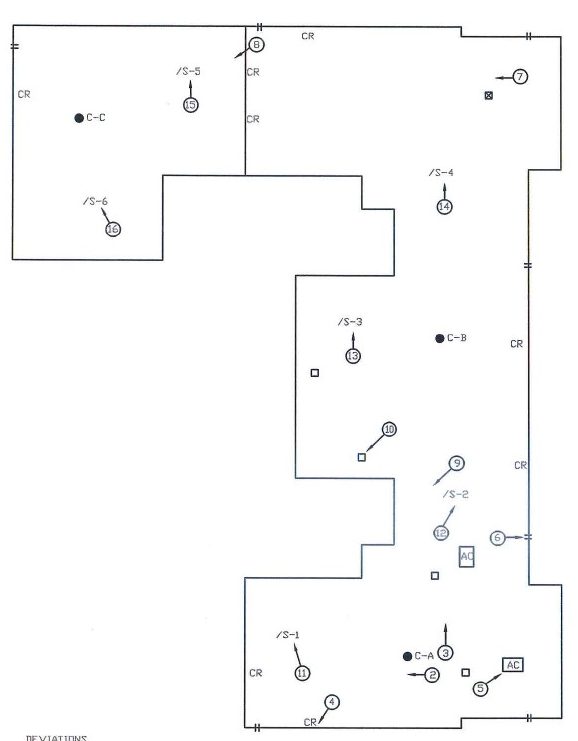
Location of core and slit samples on William Lipscomb Roof are indicated at C-A, C-B, and C-C (see Figure 4). The locations where the slit samples were taken are indicated at S-1, S-2, S-3, S-4, S-5, and S-6. The numbers 1 through 16 that are circled are the specific areas where the third-party inspector took a picture for their report, and the arrow from the numbered circle indicates the direction the picture was taken.
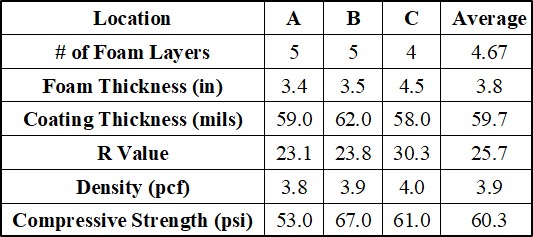
R-values were calculated on the above Table 9 by taking the foam thickness and adding 1 inch of concrete roof deck and applying the figures into the R-value calculator found at ekotrope.com (Ekotrope, 2016). The R-value above far exceeds the minimum Alpha states that it will provide, which is an R-value of 10.5.

The Alpha Program requires that the minimum Alpha roof coating thickness of the SPF application is 45 mils and SPF with a 50-PSI compressive strength. The coating thickness and compressive strength listed on Table 9 and 10 show that the roof surpassed the minimum Alpha SPF application requirements. Thom Tisthammer, from Wattle and Daub, states that the William Lipscomb Elementary School’s foam dimension stability numbers are the “best in the industry.”
Based off the third-party roof inspection on 6/8/16, the following information was compiled:

The roof received two separate 10 out of 10-customer satisfaction ratings on the project for customer satisfaction and quality from the third party inspector at Penta and from the owner. An additional comment from Corrine Berti-Craig, Trevino Group representative, who was the JOC contractor representing DISD on the job, stated, “(DFWU) did a wonderful job.”
Contractor Warranty Coverage
DFWU agreed to provide a 15-year workmanship warranty on the roof, agreeing to repair any leaks or damages on the roof due to workmanship. This workmanship warranty is 3 times the required workmanship warranty on Alpha roofs (5 years). In addition, Covestro, the foam manufacturer, provided a 15-year warranty on the foam. The industry standard and DISD’s normal standard for SPF roofing specified the installation of foam manufactured by BASF or an equivalent quality foam. However, BASF did not provide any foam manufacturer’s warranty on his or her foam to anyone at any time. Covestro providing a foam manufacturer’s warranty for the entire warrantied service life of the roof is above the standard for the industry. Finally, Neogard agreed to provide a coating warranty for 15 years, which is the Alpha standard coating warranty. Neogard’s coating warranty covers bird pecking, FM-SH hail (1.75 inches), 90 mph wind, full maintenance, and independent third-party testing and proprietary details for all 15 years. Traditional warranties provide 20-year warranties, but never actually fix the roofs if there should be a defect because they will blame the coating applicator. Neogard takes total accountability and offers a 15-year coating warranty (Kashiwagi, et al., 2015).
Conclusion
The DISD facility management/construction delivery group is not specifying the Alpha SPF roof system. A careful analysis of the cost and performance of the DISD delivery of roofing systems has identified the Alpha SPF roof system as a high performance system, which is a better value than the new modified bitumen traditional roof system being specified by the DISD engineers.
This study is a case study of an Alpha SPF roof system installed by a high performing contractor. Utilizing the expert Alpha SPF contractor, the roofing system installed saved DISD substantial savings. The approach used on this project is the JOC contract approach. The approach used an Alpha program approach that required contractor preplanning, contractor tracking time and cost deviations of the project, and manufacturers supporting the Alpha contractor with a 15 year warranty on the sprayed polyurethane foam (riskiest part of the Alpha SPF system) and a 15 year warranty on the Alpha urethane protective coating. The author, who has tracked the Alpha program for the duration of the Alpha SPF program, proposes that this roof is the highest performing Alpha SPF roof system installed, with the most meaningful warranties issued by any SPF manufacturer (manufacturer responsible for any SPF defect regardless of the source of the defect).
The Alpha Program assisted the SPF contractor to identify the roof requirements before they installed the SPF roof system, which helped the contractor to preplan the project from beginning to end. From this pre-planning afforded by the Alpha Program, the contractor was able to preplan the project, mitigate the risk that is normally caused by non-expert stakeholders, and identify project cost and time deviations throughout the project (caused either by DFWU or by the client). DFWU identified the potential to install a quality SPF roof through obtaining the warranty for 15 years from the foam manufacturer, and the SPF manufacturer. In addition, the contractor also signed a 15-year contractor workmanship warranty, understanding that DFWU is required to fix any roof defects for the 15-year duration. It was the high performance of the DFWU contractor, the correct implementation of the Alpha SPF roof system, the quality control and quality assurance Alpha system and the careful documentation of the installation that minimized the risk and delivered high project performance.
DFWU additionally documented risks and deviations throughout the project using the WRR. The WRR was able to provide transparency to all stakeholders when the deviations occurred, and demonstrated its value to the client and to the contractor.
DFWU delivered great value to DISD through the Alpha Program. The time in delivering the project was quicker, delivering the project in a total of 20 days. The cost was significantly cheaper than a traditional built-up roof, with an additional $100,000 in energy savings from the R20 value on the roof. The project received high customer satisfaction ratings as a result with both the owner giving a 10 out of 10 rating for the roof and the roof inspectors giving a 10 out of 10 roof quality rating. The roof had no punch list items. The foam’s dimensional stability figures were the “best in the industry.” Despite all of the events that could have caused delays in the project, the Alpha contractor, using the WRR, mitigated the risk, and delivered a high-quality roof system. This roof installation demonstrated how the contractors’ increased accountability led to an increase in the contractor’s performance on the job. The Alpha quality assurance and SPF roof system delivered dominant performance and demonstrated best value for DISD in terms of cost, time, and quality.
The contractor, DFWU, was the most important component to the high performance of the Alpha SPF roof installation. Both the Alpha coating manufacturer and the SPF manufacturer supported the contractor with outstanding products backed by the best warranties in the industry. The manufacturers used a quality control system (WRR) which created transparency. The third party inspection ensured the roof met the stringent Alpha requirements. The researchers propose that if this approach had been taken for all the SPF roofing installations, the DISD would have savings would be substantial.
References
- Alumbaugh, R. L., & Humm, E. F. (1984). Experimental Polyurethane Foam Roof Systems. Journal of Cellular Plastics, 257-273.
- Coffelt, D. P., & Hendrickson, C. T. (2010). Life-cycle costs of commercial roof systems. Journal of Architectural Engineering, 16(1), 29-36.
- Cory, J. (2016). Roofing Warranties: Straightening Out the Confusion. Retrieved December 2, 2017, from https://www.proremodeler.com/roofing-warranties-straightening-out-confusion.
- Ekotrope. (2016). R-Value Calculator. Retrieved August 15, 2016, from http://www.ekotrope.com/r-value-calculator/
- Gajjar, D. R., Kashiwagi, D. T., & Kashiwagi, J. (2012). Manufacturer’s New Approach To Risk. RICS COBRA 2012, 1859-1868.
- Gajjar, D., Kashiwagi, D., Kashiwagi, J., and Sullivan, K. (2014). Best Value Case Study: Cold Storage Facility in Miami, Florida. Journal for the Advancement of Performance Information and Value, Vol. 6 (1), pp. 53-71.
- Improvenet. (2014, June 17). How Much Does Foam Roofing Cost? Retrieved July 26, 2016, from http://www.improvenet.com/r/costs-and-prices/foam-roofing
- Kashiwagi, D. T., & Pandey, M. K. (1999). Standards for “Oversized” and “Severe” Hail Resistance of Elastomeric Coated Sprayed Polyurethane Foam (SPF) Roofing Systems. In Roofing Research and Standards Development: Fourth Volume. ASTM International.
- Kashiwagi, D. T. and Tisthammer, T. (2002) Information Based Delivery System for Sprayed Polyurethane Foam on Roofing, Journal of Thermal Envelope & Building Science, (26), 33-52.
- Kashiwagi, D., Gajjar, D., Kashiwagi, J., & Sullivan, K. (2015). The Replacement of Warranties with Logic and Common Sense. Journal for the Advancement of Performance Information & Value, 7(1).
- Kashiwagi, D., Gajjar, D., Kashiwagi, J., & Sullivan, K. (2016b). Hail Study on a 15 Year Old Sprayed Polyurethane Foam Roofing System. Journal for the Advancement of Performance Information & Value, 8(1).
- Kashiwagi, D., Zulanas, C., Gajjar, D. (2016a). The Cost Effectiveness of Alpha Roofs: Elementary School Case Study. Journal for the Advancement of Performance Information and Value, 8(2), 42-57.
- Knowles, M. (2005, September 29). Specifying SPF Roofing Systems. Retrieved April 17, 2013, from http://www.buildings.com/article-details/articleid/2753/title/specifying%20spf%20roofing%20systems.aspx.
- Lindus, A. (2015). 6 Ways to Void Your Roof Warranty. Retrieved December 2, 2017, from https://www.angieslist.com/articles/6-ways-void-your-roof-warranty.htm.
- Maintenance Solutions. (2015). Built-up Roofing and Modified Bitumen Systems: A Smart Roofing Decision. Retrieved July 26, 2016, from http://www.asphaltroofing.org/press-room/press-releases/built-roofing-and-modified-bitumen-systems-smart-roofing-decision
- Morin, P. (2017). Lifetime Worksmanship Warranty. Retrieved December 12, 2017, from http://rooflife-oregon.com/our-credentials/lifetime-worksmanship-warranty/.
- PBSRG. (2016a). Dallas Urethane Performance Line. Retrieved August 15, 2016, from http://pbsrg.com/app/wp-content/uploads/best-value-model/neogard/alpha-roof-rating-system/qualified-contractors/Dallas-Urethane-Performance-Line-2.pdf
- PBSRG. (2016). Performance Based Studies Research Group Internal Research Documentation, Arizona State University, Unpublished Raw Data.
- Roofing Southwest Blog (2016). 5 Ways to Void Your Roof Warranty. Retrieved July 12, 2017, from http://www.roofingsouthwest.com/blog/5-ways-to-void-your-roof-warranty.
- Shultz, M. (2016). Typical Roof Warranty Coverage Explained. Retrieved July 7, 2017, from https://www.jurinroofing.com/typical-roof-warranty-coverage-explained/.
- Zulanas IV, C. J. (2017). Cost-Effectiveness in Roofing: Alpha SPF Roofs (Doctoral dissertation, Arizona State University).
Appendix A: Progress Report
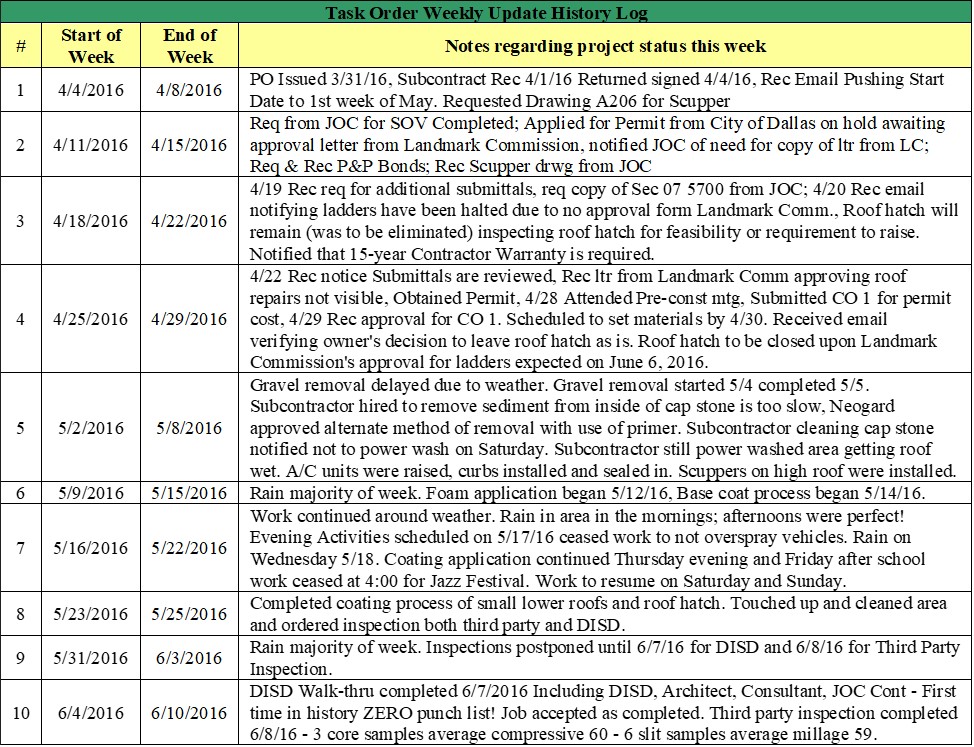
Appendix B: Milestone Schedule
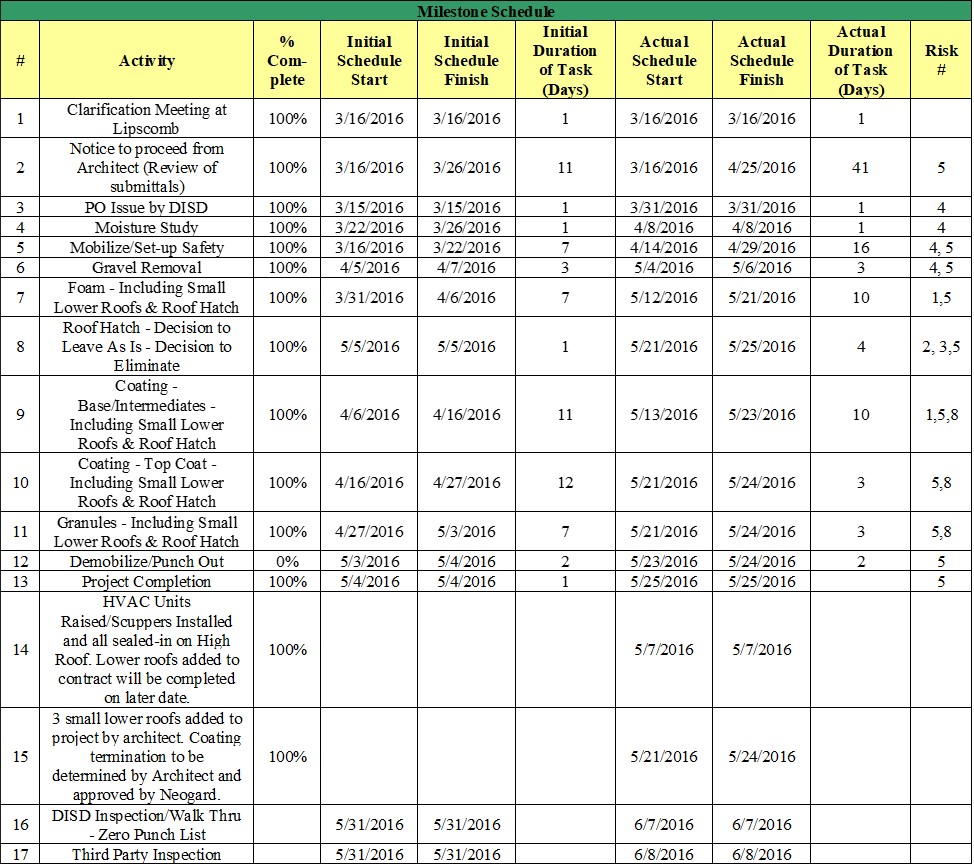 Appendix C: Risks
Appendix C: Risks
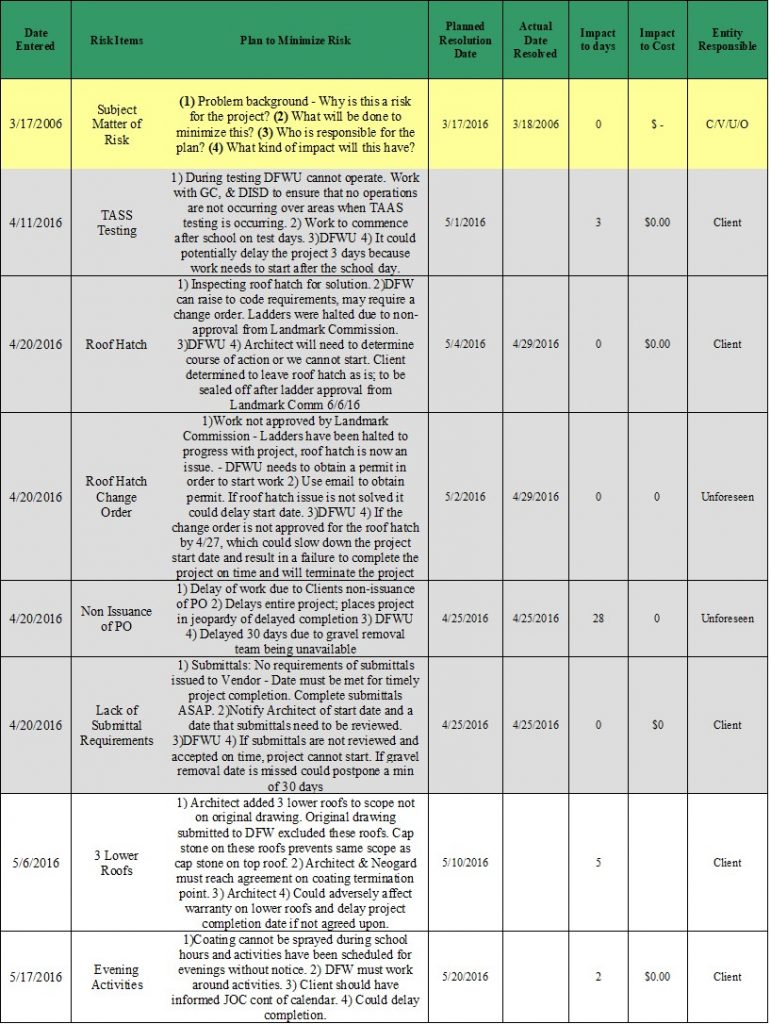 Appendix D: Performance Metrics
Appendix D: Performance Metrics

Appendix E: Report

Appendix F: Before and After Pictures of the William Lipscomb Elementary School Roof
